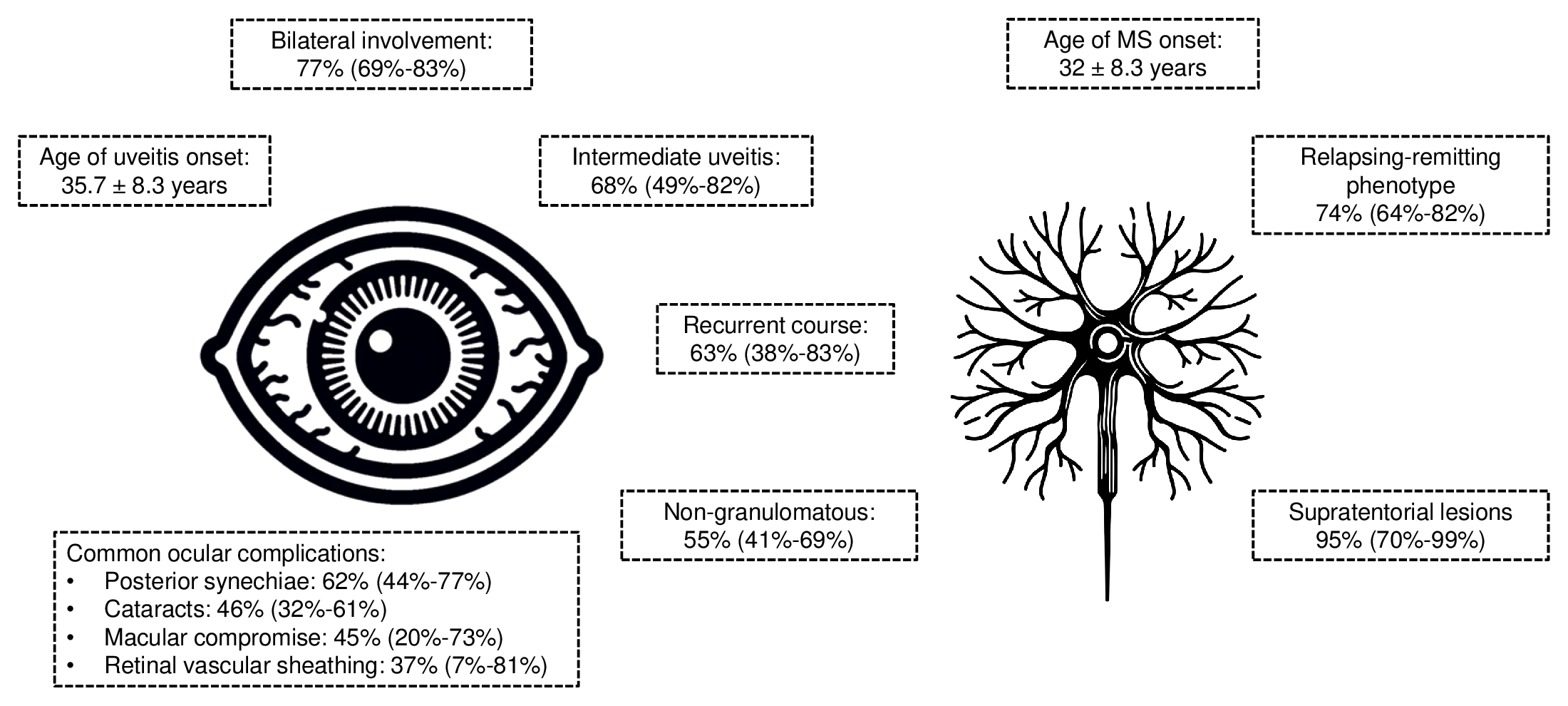Although optic neuritis is the most common ophthalmic manifestation of multiple sclerosis (MS), uveitis occurs in approximately 1% to 3% of these patients—a rate 10-fold higher than in the general population. Furthermore, MS accounts for 1% of uveitis cases. Little is known about how uveitis behaves and presents in these patients specifically, however, which led researchers to publish a new meta-analysis in the journal PLoS One. The study illuminates clinically important data that could influence diagnosis, including how multiple sclerosis-associated uveitis predominantly affects young females and typically presents as bilateral intermediate uveitis.
This paper comprised 36 studies, including 1,257 patients and 2,034 eyes with MS-associated uveitis (MSAU). The mean age was 38.2 ±12.1 years with a notable female predominance (67%). MS development before uveitis was noted in 59% of the cases, while uveitis before MS was seen in 38% of the study population. In terms of where and when uveitis occurred, the mean age for the first episode was 35.7 ±8.3 years, predominantly affecting both eyes (77%, from 23 studies involving 452 patients). Intermediate uveitis was the most frequent anatomical location (68%, from 22 studies involving 530 patients), often following a recurrent course (63%).
 |
| A recent meta-analysis published in PLoS One explores the relationship between uveitis and MS. The study analyzed data from 1,257 patients and found that bilateral intermediate uveitis is the most common presentation. The research underscores the importance of early diagnosis and tailored treatment, especially as uveitis can often present as an initial symptom of MS. This infographic from the journal article gives key findings in MS-associated uveitis. Photo: Saboya-Galindo P, et al. PLoS One. October 25, 2024. Click image to enlarge. |
Researchers also looked at the MS phenotype that occurred most frequently in patients with MSAU, of which they identified relapsing-remitting MS as the most common subtype. This form consists of frequent relapses that may leave sequelae, which remain stable between episodes. This subtype accounts for 85% of all MS cases. On imaging findings in the literature, supratentorial lesions were reported in 95% of cases in two articles involving 17 patients, while spinal cord lesions were identified in 39% of patients across two articles involving 29 patients.
According to this study, uveitis-associated complications were diverse across the literature. Sixty-two percent of cases reported occurrences of posterior synechiae, followed by cataracts in 46% of patients. Macular compromise was reported in 45%, and decreased vision was observed in 42% of cases. Treatment trends showed fingolimod was the most commonly prescribed treatment (96%, from two articles involving 196 patients), followed by interferon-beta (43%, from 11 articles involving 325 patients) and mycophenolate (48%, from four articles with 51 patients).
“These findings offer valuable insights into the clinical profile of these patients, aiding ophthalmologists and neurologists in making prompt and accurate diagnoses, which are usually complex,” the authors wrote in their paper. “For instance, uveitis has been identified as an initial symptom in 23% of MS patients. Timely neurological monitoring following the first episode of uveitis could facilitate early diagnosis and appropriate treatment.”
The authors also noted, despite the significant degree of heterogeneity among studies conducted by continent, a consistent pattern of female predominance was evident compared. For instance, 65% of the included patients in Europe were female; this proportion increased to 89% in North America. “It is worth mentioning that although genetic factors may influence sex predominance and studies conducted in North America did not exhibit significant heterogeneity, this observation was based on data from only two studies,” they wrote. “Additionally, only one study has been conducted in Africa,” underscoring the need for more comprehensive studies to more fully elucidate the relationship between sex predominance and geographical factors.
One potential limitation of this study is that the literature included was from studies conducted over a broad span of time, during which the criteria for diagnosing MS evolved. The authors also emphasized that the quality of existing evidence is limited due to the rarity of MS-associated uveitis. “Most literature primarily consists of cross-sectional studies, underscoring the need for prospective cohort studies and clinical trials,” they wrote.
Nevertheless, the authors are confident that this meta-analysis summarizes and validates uveitis characteristics and MS phenotypes of patients with an associated uveitis. “We advocate for interdisciplinary collaboration among specialists when treating patients with these clinical features to expedite diagnosis and minimize potential complications,” they concluded.
| Click here for journal source. |
Saboya-Galindo P, et al. Uveitis characteristics and multiple sclerosis phenotype of patients with multiple sclerosis-associated uveitis: A systematic review and meta-analysis. PLoS One. October 25, 2024. [Epub ahead of print.] |

